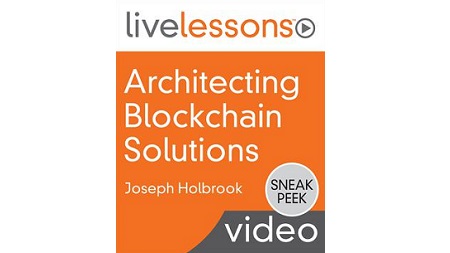
English | MP4 | AVC 1280×720 | AAC 44KHz 2ch | 5h 35m | 2.11 GB
Quickly gain a deep understanding of blockchain technology to drive revenue in your organization.
Architecting Blockchain Solutions LiveLessons covers blockchain basics, ledgers, and several use-case scenarios in detail. Learn the main technologies for supporting blockchain use cases and how these technologies work with other technologies. Joe Holbrook discusses use cases that cover financial, insurance, science, technology, and other industries that enable you to gain a full grasp of blockchain capabilities.
This course starts out by covering blockchain fundamentals, including how a blockchain compares to traditional infrastructure and how Ethereum is used as a blockchain platform. It then discusses the important factors of blockchain architectures for which every organization should have a concise understanding, including blockchain nodes, blockchain networking, and layers. Holbrook demonstrates options for running blockchain on the various public cloud providers, including AWS, GCP, Azure, and IBM, and details numerous blockchain business models and best practices for software lifecycles. He covers significant blockchain development and planning as well as several blockchain development challenges. The course finishes with a discussion of providing blockchain solutions based on customer requirements.
Topics include
- Blockchain Basics
- Understanding Ethereum
- Blockchain Platform Architectures
- Blockchain Business Models
- Defining Business Models (B2B)
- Defining Business Models (B2C)
- Defining Business Models (G2C)
- Blockchain Costing
- Blockchain Solution Development
- Blockchain Design Best Practices
- SDLC
- Building the Blockchain
- Blockchain Pre-Sales Cycle
- Blockchain Demand
Learn How To
- Understand blockchain solutions for enterprise use cases
- Discuss and sell enterprise blockchain technology technically (technical pre-sales)
- Determine appropriate enterprise blockchain solutions for technical merits
- Define testing and implementation strategies for enterprise blockchain solutions
Table of Contents
01 Architecting Blockchain Solutions – Introduction
02 Module introduction
03 Learning objectives
04 1.1 Legacy Systems Architecture vs Blockchain Architectures
05 1.2 Blockchain Overview
06 1.3 Blockchain Components
07 1.4 Enterprise Blockchains
08 1.5 Open Source Blockchains
09 1.6 Blockchain Mining
10 1.7 Bitcoin vs Blockchain
11 1.8 Key Terminology
12 Learning objectives
13 2.1 Ethereum Blockchain Platform
14 2.2 Ethereum Blockchain Networks
15 2.3 Ethereum IPFS
16 2.4 Ethereum Ledger Basics
17 2.5 Ethereum Architecture
18 2.6 Ethereum Wallets
19 2.7 Ethereum Virtual Machine
20 2.8 Ethereum Development
21 2.9 Ethereum Browser
22 2.10 Ethereum Smart Contracts
23 2.11 Ethereum dApps
24 2.12 Ethereum Tokens
25 2.13 Ethereum Gas
26 Learning objectives
27 3.1 Blockchain Architecture Overview
28 3.2 Blockchain Enterprise Architecture
29 3.3 Blockchain Architecture Domains
30 3.4 Blockchain Networks
31 3.5 Forks and Segwits
32 3.6 Blockchain as a Service (Cloud)
33 3.7 R3 Corda
34 3.8 R3 Corda (Part 2)
35 Module introduction
36 Learning objectives
37 4.1 Understanding the business models
38 4.2 Creating Value with Blockchain
39 Learning objectives
40 5.1 Defining B2B Business Model
41 5.2 Deriving Business Value in Contract Processing
42 5.3 Ripple
43 Learning objectives
44 6.1 Defining B2C Business Model
45 6.2 Defining B2C Business Challenges and Solutions
46 Learning objectives
47 7.1 Defining G2C Business Model
48 7.2 Challenges and opportunities with the G2C Business Model
49 7.3 Government of Dubai
50 Learning objectives
51 8.1 Blockchain Cost Model
52 8.2 Cost Considerations
53 Module introduction
54 Learning objectives
55 9.1 Project Planning Best Practices
56 9.2 Project Planning Best Practices
57 9.3 Development Frameworks
58 Learning objectives
59 10.1 Design Decisions
60 10.2 Development Skills
61 Learning objectives
62 11.1 SDLC and the Blockchain
63 11.2 Defining Development Models
64 Learning objectives
65 12.1 Steps to Building Your Blockchain
66 12.2 Blockchain Development Tools
67 Module introduction
68 Learning objectives
69 13.1 Customer Requirements
70 13.2 Understanding Use-Cases
71 13.3 Responding to Proposals (RFPs)
72 13.4 RFP for Fin Tech
73 13.5 Proof of Concepts (POC)
74 13.6 ROI and TCO
75 Learning objectives
76 14.1 Demand in the Blockchain
77 14.2 Blockchain Roles
Resolve the captcha to access the links!